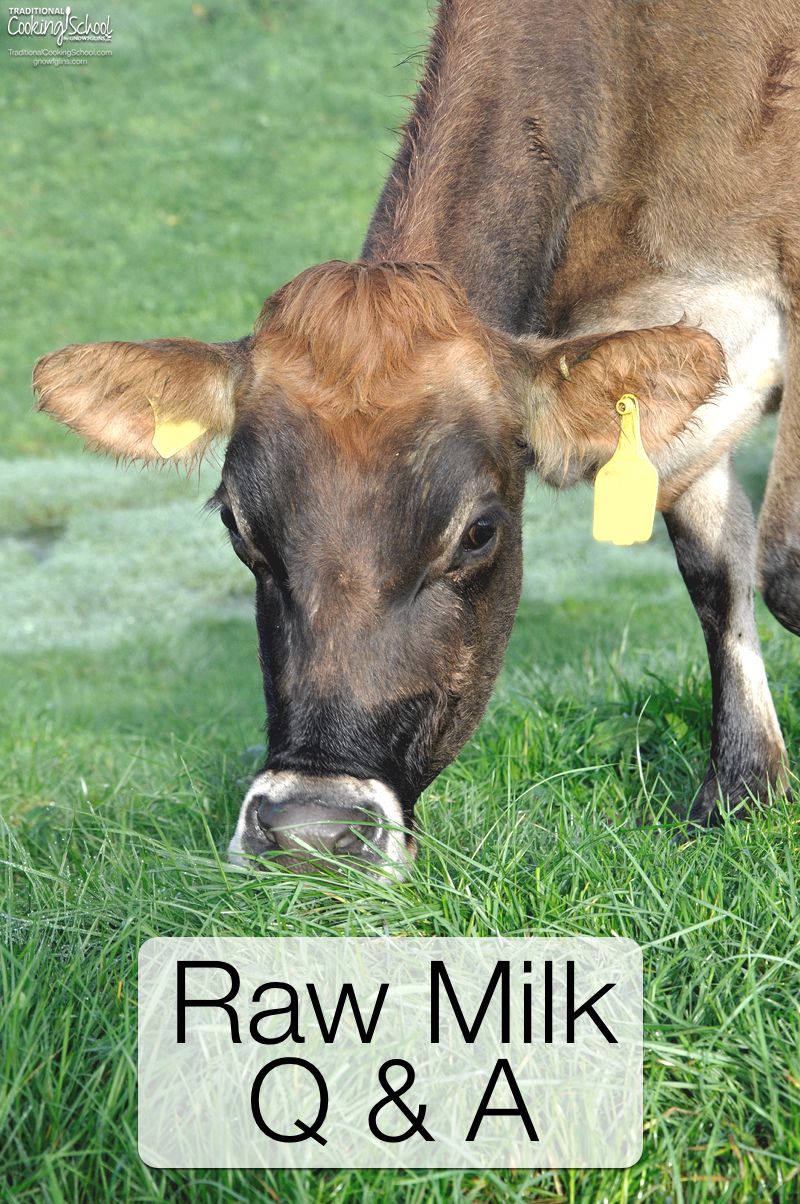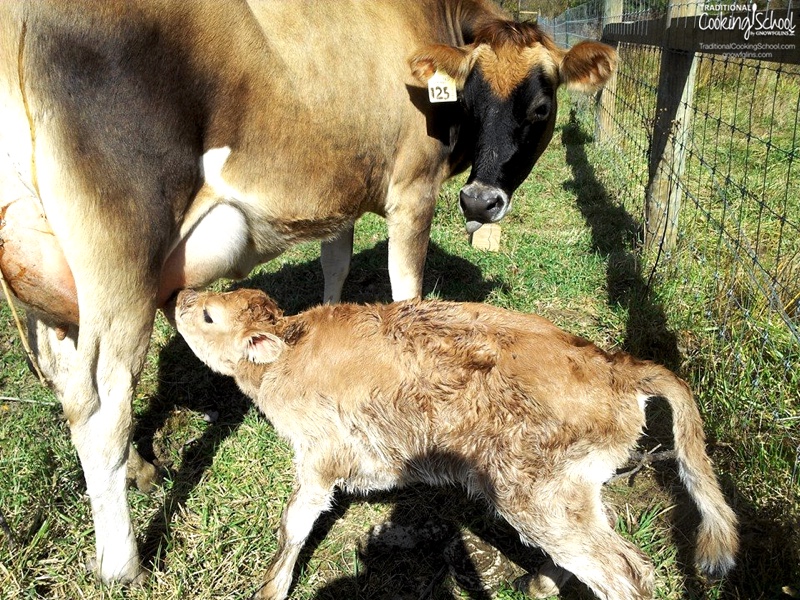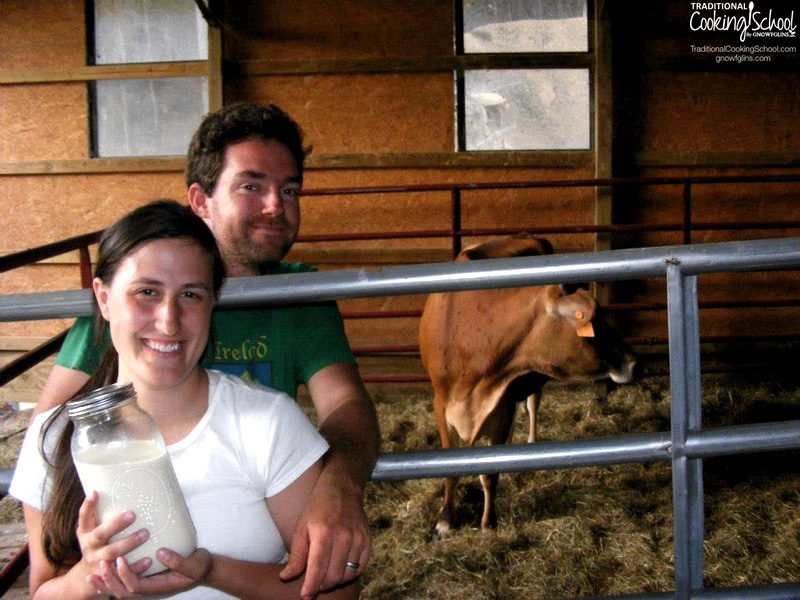
Organic produce and raw milk are the two most common “gateway” foods for people who want to make changes to their diet. The extra work involved with organic produce — chopping, prep, and cleanup — can be enough to make some people give up.
With raw milk, however, it’s a simple switch. Just swap out your store milk for the local raw milk. The hardest part is getting in the habit of shaking before you pour. 😉
The creamy, delicious taste of raw milk makes this real food switch a luscious treat instead of a chore.
With the idea of raw milk as a good starting place for many newly health-conscious families, I decided to go to one raw milk-producing family farm and ask some important questions. I contacted Fall Creek Farms located near the Cumberland Plateau in east central Tennessee.
The farm is home to three generations of the Bleasdale family. In compliance with Tennessee state laws, they run herdshares for cows and goats as well as raising grassfed meats and operating a vegetable CSA.
To answer my questions, JoAnna Bleasdale kindly gave me some of her precious free time while her baby napped.
Is it safe?
This is the number one question people ask about raw milk. Even the CDC’s own statistics show that raw milk hasn’t killed anyone in a long time.
After my phone call with JoAnna, I looked it up and found this interesting statistic: During the ten years from 1998 to 2008, there were over 1 million deaths from FDA-approved prescription drugs; around 8,000 deaths from USDA-approved produce, poultry, pork, fish and beef; but zero deaths from raw milk.
We understand that anything we put on or in our bodies carries some kind of risk. This is inevitable, but we can do our best to minimize this risk by choosing whole, unprocessed foods from local sources and educating ourselves.
Raw milk, a whole, unprocessed food most commonly purchased from within the local community, is exactly that. However, it is up to each individual to make their own informed choices regarding diet and nutrition. For additional reading about the benefits of raw milk go here or here.
Is organic milk the same thing as raw milk?
Organic milk bought in the grocery store is pasteurized and homogenized, and often even UHT (ultra-high temperature) pasteurized.
The pasteurization process cooks the milk before chilling it for sale, thereby inactivating, inhibiting, or completely destroying the naturally-occurring enzymes, probiotics, beneficial omega-3 fats, bio-available vitamins and minerals, and immune-boosting substances.
Homogenization is the process by which cream is made to stay dispersed throughout the milk instead of rising to the top.
Organic milk intended for pasteurization usually comes from cows eating organic soy and grain-enriched feeds instead of primarily grass.
Large milk processing plants co-mingle all of the milk from all of its dairies, skim the cream, and then return the portion of cream needed to fulfill USDA requirements for whole or low-fat milk. (Remember, the cream is where the vast majority of the vitamins are in milk.)
They are then left with extra cream to make other products. Pasteurization and homogenization both denature and oxidize proteins and fats within the milk, which may be the reason for many milk intolerances.
Raw milk is not pasteurized or homogenized.
The cream content varies with the breed of cow, ranging from 2.9% to 4.9% but nearly always exceeding the USDA minimum of 3.25%.
Cows producing milk intended for raw consumption should be on a grass-based diet. Grains and other feed should be supplemental, not the basis of the diet.
Raw milk retains all of the enzymes including lactase which naturally helps digest lactose, phosphatase which facilitates calcium absorption, and lipase which aids in fat digestion. It also retains all of the naturally-occurring butterfat along with a diverse probiotic population.
How do I know if I’m getting raw milk from a good source?
JoAnna’s advice? Talk to your farmer a LOT! Don’t be afraid to ask questions.
Ask to see the farm and the milking facilities. Showing interest in the farm helps you connect with your farmer. Give them the chance to show off the place. Ask how they wash, scrub, and dry the udders before milking. Ask how they clean their milking equipment. Ask what the cows eat, where they live, and how they are treated.
Happy cows really do make better milk. At Fall Creek Farms, the cows eat mostly grass with some non-GMO grains and a little sorghum silage. Don’t be afraid to ask your farmer about whether they use GMO feed.
How long does raw milk last?
This all depends on how the milk was handled from the moment of milking until it reaches your refrigerator.
According to JoAnna, the best flavor and longest shelf-life are attained when the milk is cooled to 40 degrees Fahrenheit within 2 hours of milking. The longer it takes for the milk to reach that temperature, the shorter the shelf-life and the greater the risk of contamination.
Fall Creek Farms milk is cooled to 40 degrees within 15 minutes of milking.
Additionally, milk needs to be transported safely from the farm. Place it in a cooler and cover it with ice. Refrigerate right away once home.
If you find your milk is souring too quickly, your refrigerator might be too warm. Get a thermometer and check to make sure your temperature is between 36 and 40 degrees Fahrenheit.
Well-handled milk can stay fresh and sweet-tasting for two weeks or even longer.
Can anyone drink raw milk?
A few of JoAnna’s customers have told her that they were never able to drink milk until they started drinking raw milk.
She finds that, for the most part, lactose-intolerant people can drink raw milk. Goat milk is even better tolerated. Even those with casein intolerance sometimes do well with goat milk because the protein in goat’s milk is structured differently.
If raw milk is cultured into yogurt or kefir, it is even more widely tolerated and allows people with digestive issues to benefit from the nutrition in dairy products.

Why is raw milk more expensive?
In Tennessee, the local store brand of milk (Mayfield) is about $6 per gallon. Fall Creek Farms charges $8 per gallon. The Whole Foods in Chattanooga charges as much as $10 to $12 per gallon for their organic milk.
At least in Tennessee, raw milk isn’t such a budget breaker, but where I live in Florida, it is much harder to find raw milk for anything less than $10 per gallon. It is much harder to be a dairy farmer in a state where it’s 90 degrees Fahrenheit or hotter for nearly half of the year! 😉
JoAnna said to look at it this way: You are paying for a superior product. Not only is it healthier, but the milk is going to taste better than any store-bought milk, especially if it comes from heritage breeds like Jersey or Guernsey.
It’s an artisan product, along the same lines as craft beer.
What do farmers do with extra milk?
It is common practice to skim off the cream and use it in coffee, put it on fruit, make it into ice cream, or churn it into butter. The leftover skim milk is then fed to the pigs to fatten them up. JoAnna’s recently-raised milk-fed hogs were some of the yummiest, tenderest pork she’d ever had!
Skimmed or leftover milk can also be given to the chickens as a calcium supplement for better eggshells, added to garden soil to help it retain moisture, or (of course) fed to calves.
When Traditional Cooking School founder Wardee had a dairy cow, they clabbered much of their extra milk to create soy-free chicken feed.
Why does raw milk taste different from state to state and even farm to farm?
Store milk tastes pretty much the same no matter where you get it since pasteurization burns out much of the flavor. Some people even say that pasteurized milk tastes ashy and burnt.
For raw milk, though, many factors affect the taste. Breed of cow, pasture, season, glass or plastic containers, fresh milk, older milk, etc.
I once did a side-by-side taste test of Jersey, Guernsey, Brown Swiss and Ayrshire milk with people at a Weston A Price Foundation event. Nearly everyone could taste the difference between each kind.
JoAnna can tell which cow her milk comes from because they each have their own distinctive flavor. She loves the milk from their herd “queen” who apparently gives milk so luscious that even her colostrum tastes good!
What is good farm etiquette?
Many states allow sales of raw milk from the farm only. This means you need to ask your farmer about any farm “rules”. One farmer I know always makes sure her customers know to close any gate because her horses love to escape.
JoAnna says it’s always a good idea to wait and make sure the farmer is there before you go on site. If you want a tour to see a milking, then you should be prepared to get there early (as in, 5 in the morning). For the most part cows are friendly, gentle creatures who like to be petted, but they can get ornery too. If your farmer says don’t touch, respect that.
Also, be careful going from farm to farm. Don’t track things in on your shoes from the last place you visited. Animals can get sick from thoughtless visitors.

If you have more questions about raw milk, cows, or goats, you are welcome to contact the Bleasdales on their Fall Creek Farms website or on their Facebook page. They will be happy to talk to you. I’m thankful for JoAnna’s generous time given to answer my questions, and I’m thankful there are wonderful farm families like theirs producing delicious, safe raw milk!
In the comments: Tell us what you’ve learned from your raw milk farm!
We only recommend products and services we wholeheartedly endorse. This post may contain special links through which we earn a small commission if you make a purchase (though your price is the same).


We have been drinking the Bleasdales’ beautiful milk for about two years now!! We are so thankful for their care and attention, and that we have access to such an amazing food! Great work, guys!!
Here in Pennsylvannia we are blessed to have many amazing farms! I LOVE the milk at Beulah land Jerseys in Lebanon county. And best of all it is only 5$ a gallon!! With spring here the milk will have cream that is between 1/4 and 1/3 of the gallon! If you are ever in the area I highly recommend it!
Very interesting article, well written and very informative. I even learned some things though I am JoAnna’s mother and we talk about this subject frequently.
😀
Thanks!
I really miss raw milk (it was recently made illegal to produce/sell raw milk in Victoria, Australia) and I wish this information was more wide-spread here.
Have shared the post with my followers this week, in the hopes that those living in areas where raw milk is legal will try it and love it 🙂
thank you for sharing – it is important to keep the channels of information open and flowing!
This is fascinating. I have been researching the benefits of raw milk, however, in doing so I discover that it is illegal to purchase raw milk here in the great state of Louisiana. It is legal to give it away but not purchase. Do you have any information or advise for approaching law makers to encourage them to change this law? Thanks!
My first recommendation is to contact the Farm to Consumer Legal Defense Fund and ask them about efforts to bring raw milk back to Louisiana. They would be able to help direct you as to how to talk to lawmakers and which ones to contact in your area.
A second idea depending on how close you are to Texas, Arkansas or Mississippi is to form a private buying club and purchase milk from one of those states where it is legal.
Lastly I recommend getting involved with your local Weston A Price Foundation chapter. They will know more about details for farm fresh food in your area as well as any legislation or actions to be taken. http://www.westonaprice.org/get-involved/find-local-chapter/
Thank you so much for this information. It is very helpful and makes me hopeful that raw milk could be in my families near future.
It has been many years sense I had raw whole milk but I can still remember
the great taste compared with the junk sold in stores today…
Wish I knew where to find raw whole milk and real country eggs !!!
Depending on where you live there may be a Weston A Price Foundation chapter in your area. The chapter leader can help get you connected.
http://www.westonaprice.org/get-involved/find-local-chapter/
Sorry,my sleepy brain momentarily stopped working…
Should have said “since” not sense !!!
Hi Lee,
Thank you for your wonderful article on raw milk! Excellent information!
I live in Vero Beach, FL…just about 1 1/2 hours southeast of Orlando: )
Wanted to let you know that Joash’s Raw Dairy (Blountstown, FL) delivers raw dairy to us every other week and 1 gallon of raw milk is only $8.50 and 1/2 gallon of raw yogurt is only $6.50. They also offer raw chocolate milk, cream and butter: )
Just thought I would mention in case they deliver to your area and you could save a bit of money!
Hi Jennifer,
Do you have the contact information for joashs farm? I can’t seem to find it online…
I cant find it either.
Joash – I’ve had their milk and cream and it is delicious! I’m sorry I don’t have contact info for them because I usually buy it through the farmers markets instead of directly from Joash. You might contact Heart of Christmas Farms in Christmas, FL. They may have the contact info.
Joash is the product name. It comes from Ocheesee Creamery.
Can you use whole milk to make yogurt whey??
Yes – I think I’m understanding your question as you want whey? You can allow raw milk to clabber and then separate the whey from the solids. If you are wanting yogurt whey specifically then you will have to make yogurt from the whole milk first and then drain it to capture the whey.
You can learn more about whey from this free video that Wardeh made:
https://traditionalcookingschool.com/2011/07/20/free-video-whey-what-it-is-how-to-get-it/
Great article! I just wish I could find raw milk in my area…
Just found Joash Raw Milk a few weeks ago at a health food store in Niceville, FL. That’s a 45 min. drive for me. Does anyone know how I can find out if I can get it anywhere closer? I live almost on the Alabama line north of Defuniak Springs, FL.
Pam, I know they are in Blountstown, FL. I get their products in Southwest Ranches, in Southeast FL. I can’t find contact info for them online. I would the store @ Niceville that you found the raw milk at to contact them for you, or have them give you a way to contact them directly. Good Luck.
Web site is ocheeseecreamery.com.
Raw and milk with pregnancy. Thoughts? We love it. But curious with pregnancy if caution should be exercised or produce as usual. Thank you!